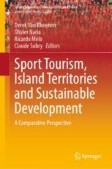Search
Search Results
-
The Summer Distribution of Sculpin Fish (Cottidae) on the Continental Margin of the Sea of Japan from Cape Povorotny to Cape Mapatsa
AbstractWe identified Gymnocanthus detrisus as the absolute dominant species in the taxocene of sculpins (family Cottidae ) caught below the 20-m...

-
Gentoo Penguins (Pygoscelis papua) started using mosses as nesting material in the southernmost colony on the Antarctic Peninsula (Cape Tuxen, Graham Land)
The population of Gentoo Penguins ( Pygoscelis papua ) in the maritime Antarctic is rapidly increasing. Due to regional climate changes, they colonise...

-
The tardigrade Mesobiotus aradasi (Binda, Pilato & Lisi, 2005) is widely distributed along the Antarctic Peninsula
Antarctica is considered one of the most inhospitable places to life due to its low temperatures and lack of liquid water. However, meiofauna taxa...

-
Assessing impacts of mining on provisioning ecosystem services in a culturally diverse landscape of Western Cape York, Australia
ContextMitigating the impacts of mining on biodiversity and ecosystem services (ES) is critical for maintaining human wellbeing in mineral-rich...

-
Update on the abundance and distribution of Macaroni Penguins (Eudyptes chrysolophus) in the Antarctic Peninsula region
Several studies have examined the potential impacts of climate change on the abundance and distribution of Antarctic penguin species, particularly in...

-
An estuarine system as a possible nursery habitat for the broadnose sevengill shark: San Antonio cape—Southwest Atlantic
The nursery habitats of the broadnose sevengill shark Notorynchus cepedianus (Péron, 1807) remain largely unknown. The identification of these...

-
The First Data on Mesostigmatic Mite Assemblages (Parasitiformes, Mesostigmata) from a Coastal Area of the Eastern Black Sea Region (Abrau Peninsula, Krasnodar Territory)
AbstractA study of different coastal habitats carried out in the autumn of 2019 and 2020 in the vicinity of Cape Malyi Utrish (Abrau Peninsula,...

-
Distribution of Boeckella poppei (Copepoda: Centropagidae) in the region of the Wilhelm Archipelago (Kyiv Peninsula, Maritime Antarctica)
Copepod Boeckella poppei was first recorded in a freshwater body of the Wilhelm Archipelago (Kyiv Peninsula, Maritime Antarctica) in 2008. This...

-
Environmental correlates of non-marine ostracod (Crustacea: Ostracoda) assemblages of the Eastern Cape (South Africa)
The present study investigates the ecology and distribution of ostracod species and assemblages from 62 inland waterbodies in the Eastern Cape...

-
Patterns of surface temperature and link to environmental variables in Weddell seals from the western Antarctic Peninsula
Pinnipeds face challenges in maintaining a stable body temperature in two mediums with distinct characteristics: the terrestrial and aquatic...

-
Diversity, ecology, and community structure of the terrestrial diatom flora from Ulu Peninsula (James Ross Island, NE Antarctic Peninsula)
Diatoms constitute an important and diverse component of terrestrial protist communities but remain poorly studied, especially in the Antarctic...

-
Population decline of the cape petrel (Daption capense) on King George Island, South Shetland Islands, Antarctica
The Antarctic and the surrounding Southern Ocean are currently subject to rapid environmental changes and increasing anthropogenic impacts. Seabird...

-
Cape Hare Lepus capensis Linnaeus, 1758
This comprehensive species-specific chapter covers all aspects of the mammalian biology, including paleontology, physiology, genetics, reproduction...
-
Long-distance migrations and seasonal movements of meagre (Argyrosomus regius), a large coastal predator, along the Iberian Peninsula coast
BackgroundThe meagre, Argyrosomus regius , is a large coastal predatory fish inhabiting waters from the north-eastern Atlantic and Mediterranean Sea,...

-
Biological Characteristics and Nutrition of the Shrimp Crangon crangon (Decapoda, Crangonidae) near Kindo Peninsula, White Sea, July–August 2006–2007
AbstractThe length of the carapace in Crangon crangon varies from 4.5 to 10.6 mm in males and from 4.2 to 15.2 in females. Males are characterized...

-
Japan: The Sustainable Development of a Small Peninsula: The Case of Irago Triathlon
The problems caused by Japan’s declining birthrate, aging population, and depopulation are more severe in the tip of the peninsular regions than in...
-
Feel the beat: cape fur seal males encode their arousal state in their bark rate
The cape fur seal is one of the most colonial mammal species in the world. Breeding colonies are composed of harems held by mature males (older than...

-
Diverse marine benthic communities and reduced anthropogenic contaminants near Scott Base (Hut Point Peninsula, Ross Island, Antarctica)
Antarctic marine ecosystems are largely thought to be among the planet’s least impacted, yet habitats adjacent to research stations can be heavily...

-
Diversity and Endemism of the Marsupials of Australia’s North-Eastern Tropics
Australia’s north-eastern tropics (the Wet Tropics and Cape York Peninsula bioregions) comprise diverse assemblages of environments, from the world’s...
-
On Widening the Hybrid Zone for Chars of Genus Salvelinus, Kundscha S. leucomaenis and Northern Dolly Varden S. malma (Salmonidae), in Rivers of Kamchatka Peninsula
Abstract —The data on widening the zone for hybridization between the chars of the genus Salvelinus , kundscha S. leucomaenis and northern dolly...

